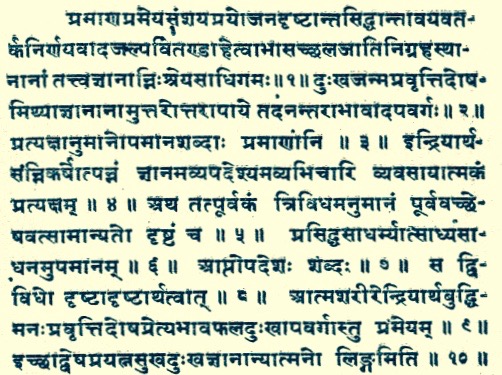|
Pakṣilasvāmin Vātsyāyana
Pakṣilasvāmin Vātsyāyana was an Indian philosopher, commentator and logician of the Nyaya School. He is the author of the Commentary, "Nyāya", the first full commentary on the Nyāya-sūtra of Nyāya Sūtras, Gautama (c. 150 CE), which is itself the foundational text of the school of philosophy called "Nyaya, Nyāya". Works ''The Nyayabhasya'' is the first commentary on the Nyaya sutras that is still extant, and the first to which we find any reference. Vātsyāyana's commentary sets the agenda for much of Nyāya's philosophical developments throughout its history. His theory of knowledge gives special attention to the nature and importance of cognition as a guide to action. This theme informs several elements of his project, including his realism, his account of epistemic entitlement, and his notion of philosophy's contribution to living well. References {{reflist See also * Nyaya * Nyāya Sūtras, Nyaya Sutras Indian logicians Indian philosophers Year of birth unknow ... [...More Info...] [...Related Items...] OR: [Wikipedia] [Google] [Baidu] |
Nyaya
(Sanskrit: न्याय, ''nyā-yá''), literally meaning "justice", "rules", "method" or "judgment",Nyaya: Indian Philosophy Encyclopædia Britannica (2014) is one of the six '' astika'' schools of . This school's most significant contributions to Indian philosophy were systematic development of the theory of , methodology, and its treatises on epistemology. |
Nyāya Sūtras
The ''Nyāya Sūtras'' is an ancient Indian Sanskrit text composed by , and the foundational text of the Nyaya school of Hindu philosophy. The date when the text was composed, and the biography of its author is unknown, but variously estimated between 6th-century BCE and 2nd-century CE.Jeaneane Fowler (2002), Perspectives of Reality: An Introduction to the Philosophy of Hinduism, Sussex Academic Press, , page 129 The text may have been composed by more than one author, over a period of time. The text consists of five books, with two chapters in each book, with a cumulative total of 528 aphoristic sutras, about rules of reason, logic, epistemology and metaphysics.Jeaneane Fowler (2002), Perspectives of Reality: An Introduction to the Philosophy of Hinduism, Sussex Academic Press, , pages 127–136 The Nyāya Sūtras is a Hindu text, notable for focusing on knowledge and logic, and making no mention of Vedic rituals. The first book is structured as a general introduction and ... [...More Info...] [...Related Items...] OR: [Wikipedia] [Google] [Baidu] |
Indian Logicians
Indian or Indians may refer to: Peoples South Asia * Indian people, people of Indian nationality, or people who have an Indian ancestor ** Non-resident Indian, a citizen of India who has temporarily emigrated to another country * South Asian ethnic groups, referring to people of the Indian subcontinent, as well as the greater South Asia region prior to the 1947 partition of India * Anglo-Indians, people with mixed Indian and British ancestry, or people of British descent born or living in the Indian subcontinent * East Indians, a Christian community in India Europe * British Indians, British people of Indian origin The Americas * Indo-Canadians, Canadian people of Indian origin * Indian Americans, American people of Indian origin * Indigenous peoples of the Americas, the pre-Columbian inhabitants of the Americas and their descendants ** Plains Indians, the common name for the Native Americans who lived on the Great Plains of North America ** Native Americans in the Uni ... [...More Info...] [...Related Items...] OR: [Wikipedia] [Google] [Baidu] |
Indian Philosophers
Indian philosophy refers to philosophical traditions of the Indian subcontinent. A traditional Hindu classification divides āstika and nāstika schools of philosophy, depending on one of three alternate criteria: whether it believes the Vedas as a valid source of knowledge; whether the school believes in the premises of Brahman and Atman; and whether the school believes in afterlife and Devas. There are six major schools of Vedic philosophy— Nyaya, Vaisheshika, Samkhya, Yoga, Mīmāṃsā and Vedanta, and five major heterodox (sramanic) schools—Jain, Buddhist, Ajivika, Ajñana, and Charvaka. However, there are other methods of classification; Vidyaranya for instance identifies sixteen schools of Indian philosophy by including those that belong to the Śaiva and Raseśvara traditions.Cowell and Gough, p. xii.Nicholson, pp. 158-162. The main schools of Indian philosophy were formalised and recognised chiefly between 500 BCE and the late centuries of the Common Era. ... [...More Info...] [...Related Items...] OR: [Wikipedia] [Google] [Baidu] |
Year Of Birth Unknown
A year or annus is the orbital period of a planetary body, for example, the Earth, moving in its orbit around the Sun. Due to the Earth's axial tilt, the course of a year sees the passing of the seasons, marked by change in weather, the hours of daylight, and, consequently, vegetation and soil fertility. In temperate and subpolar regions around the planet, four seasons are generally recognized: spring, summer, autumn and winter. In tropical and subtropical regions, several geographical sectors do not present defined seasons; but in the seasonal tropics, the annual wet and dry seasons are recognized and tracked. A calendar year is an approximation of the number of days of the Earth's orbital period, as counted in a given calendar. The Gregorian calendar, or modern calendar, presents its calendar year to be either a common year of 365 days or a leap year of 366 days, as do the Julian calendars. For the Gregorian calendar, the average length of the calendar year ( ... [...More Info...] [...Related Items...] OR: [Wikipedia] [Google] [Baidu] |


